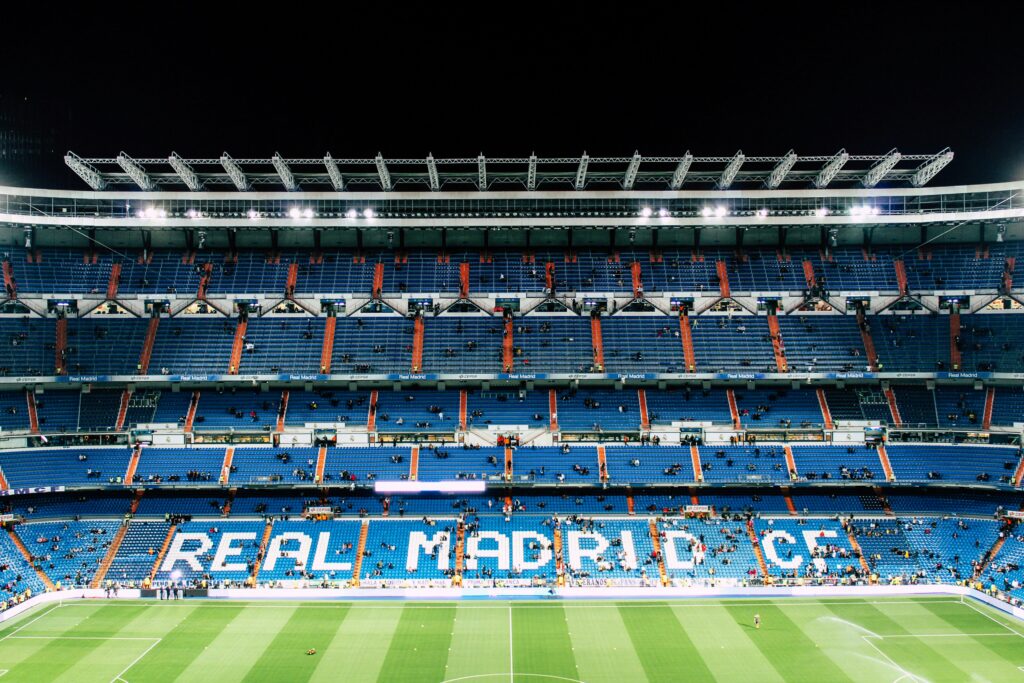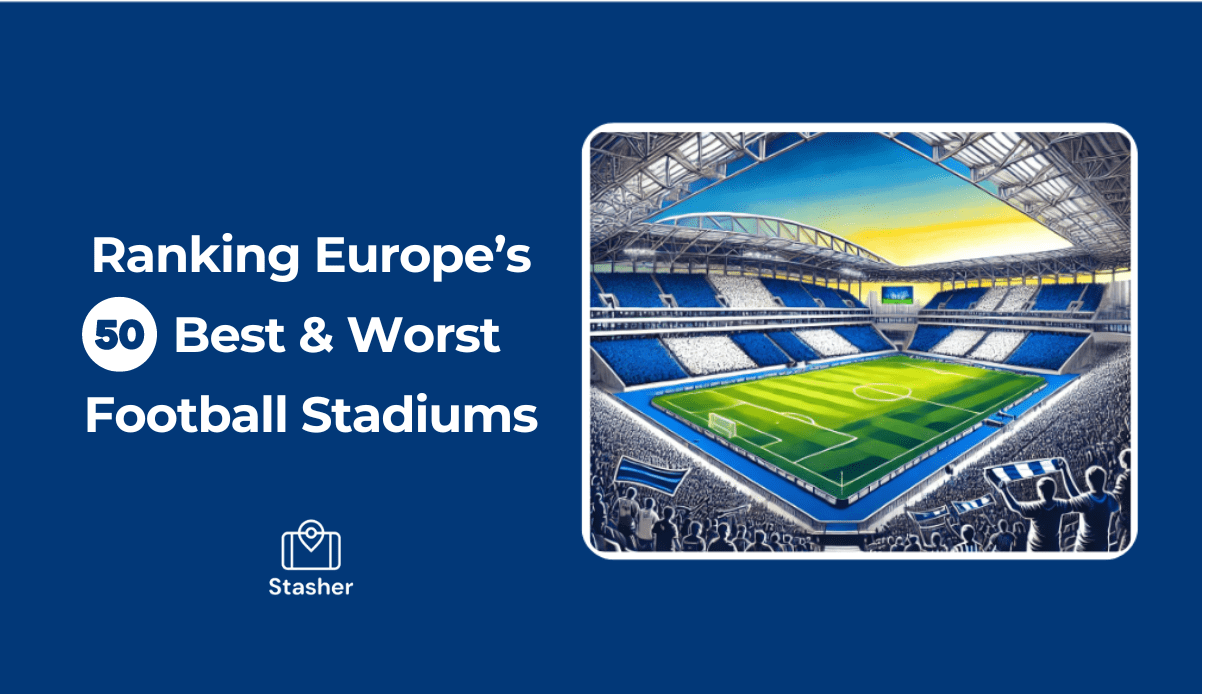Football is by far the world’s most popular sport, with 3.5 billion fans globally. Amongst this global obsession, Europe holds the five biggest football leagues and people tune in regularly to watch these televised clashes.
- 1 – Premier League (UK)
- 2 – Bundesliga (Germany)
- 3 – LaLiga (Spain)
- 4 – Serie A (Italy)
- 5 – Ligue 1 (France)
To host these games, huge stadiums have been built over the last century in cities all across the continent, attracting 209 million fans to the stands in the 2022/2023 season according to a UEFA report. At Stasher we took it upon ourselves to dig a little deeper and rank these core locations of European football.
Download the Stasher app to find convenient luggage storage when visiting these locations. IOS or Android.
Key findings:
- Of the 50 stadiums analysed, Signal Iduna Park (5.94) – home of Borussia Dortmund and site of the Euro 2024 semi-final – ranks in first position as the best stadium in Europe. Known for its famous yellow-wall and notoriously good atmosphere, this stadium ranks well in all categories, with a large capacity (81,365), reasonable average ticket price (35€), and very good public accessibility, complemented by excellent Google reviews (4.7/5).
- Real Madrid’s Santiago Bernabeu Stadium ranks second. With a high capacity (81,044) and outstanding disabled access, it also offers a very low cost of a pint (2.5€) and great Google reviews (4.6/5), making it a top choice. Barcelona’s Camp Nou ranks third, just losing out to its Spanish rival. The largest stadium in the list with a capacity of 99,354, Camp Nou also boasts great disabled access and good public transport connections.

- Coming in fourth, but reigning supreme in the UK, is Manchester’s Old Trafford (5.52). Renowned for its exceptional disabled access and excellent transport links, this iconic stadium boasts a capacity of 74,140 and very positive Google reviews (4.6/5). Completing the top five is Milan’s legendary San Siro, the shared home of rival clubs Inter Milan and AC Milan. For years, rumours of its demolition have circulated, threatening to erase a piece of football history. Recently, however, these plans were halted due to arguments for its cultural significance.
To give you some context, the factors we took into account in order to rank the stadiums were the following:
- Stadium capacity (the higher the better)
- Average ticket price (the lower the better)
- Cost of a pint (the lower the better)
- Ease of access (via public transport)
- How good the disabled access is (accessible toilets, elevators, ramps, wheelchair-accessible seating etc.)
- Online reviews (specifically Google ratings)
At first, after doing our research, this is the initial table we came up with:
You can also access our Google Sheet here.
Note: All data is valid as of July 2024
As you can see, the stadiums are ranked from highest to lowest in terms of capacity (Column D), with the rest of the columns containing the data from the factors we listed earlier.
Plus, a bonus column with the closest metro station to each stadium!
Let’s have a closer look at our data based on the factors and see how the stadiums “score” based on each one.
Factor #1: Capacity 💺
This is pretty straightforward.
From the 50 European football stadiums in our analysis:
- The highest capacity was that of Camp Nou in the city of Barcelona, home to Barcelona FC with a maximum capacity of 99,354
- The lowest capacity was that of BayArena in Germany, home to Bayer Leverkusen with a maximum capacity of 30,210
While the median value in terms of capacity is 60,577!
So here are the top 10 stadiums with the highest capacity:
And in the form of a table too:
Factor #2: Average Ticket Price 🎟️
In these tough economic times, paying to watch your favorite team play can be quite pricey, which is why we consider the average ticket price to be an important factor.
Note: To determine the price, we’ve excluded events outside of football that may take place in a stadium (cricket, concerts etc).
So based on our research:
- The stadium with the highest ticket price is Old Trafford, home to Manchester United, with an average ticket price of 118.44€
- The stadium with the lowest ticket price is Boris Paichadze Dinamo Arena, in Tbilisi Georgia, with an average ticket price of 10€
While the median ticket price is 30€.
Here are the 10 stadiums with the cheapest ticket price on average:
Let’s continue to our next factor.
Factor #3: Cost of a Pint 🍺
If you’re from a country like the UK, then this is probably the most important factor.
In fact, the cost of a pint in football stadiums has been on a climb recently and some studies even suggest that it can go up to £13 by 2030 (yikes!).
Our research found data for 39/50 stadiums and here are the results:
- The stadium with the highest cost of a pint is the Emirates Stadium in London, home to Arsenal FC (7,45€).
- The stadium with the lowest cost is Boris Paichadze Dinamo Arena in Tbilisi, with a pint costing 1,67€
With the median price being 5€.
Here’s a list of the 10 stadiums with the lowest cost for a pint:
Factor #4: Ease of Access 🚎
No matter how spectacular a stadium might be, it’s pointless if you can’t get there easily, right?
That’s why we divided all 50 stadiums into 2 categories:
- Good
- Average
Based on how easy it is to get there via public transportation (metro, train, bus).
Luckily, only 8 stadiums turned out to be average, with the rest being good and relatively easy to get to, since the majority have a metro line quite close.
For instance, you can get to Wembley stadium from three railway stations, while Ljudski Vrt Stadium in Slovenia only has a bus station in a close proximity.
Factor #5: Disabled Access 👩🦽
While the capacity and cost of a pint can be “important”, whether a stadium is accessible to physically impaired people is really important to consider.
Luckily, many of the top football stadiums in Europe have sections dedicated to people with disabilities, such as:
- Wheelchair-accessible seating
- Accessible toilets
- Dedicated parking spaces
- Elevators and ramps
And even audio commentary.
So we categorized our 50 stadiums into:
- Great
- Average
- Poor
In order to determine how accessible they are to disabled people.
Our analysis has shown that:
- 20 stadiums are “Great”
- 21 stadiums are “Average”
- 9 stadiums are “Poor”
And here are the 20 stadiums with “Great” accessibility for disabled fans:
Factor #6: Online Reviews ⭐️
Last but not least, it only made sense to rank our stadiums based on their Google ratings.
The good thing is that no stadium has received a rating less than 4 out of 5 stars, with the highest ratings being 4.7 for several stadiums, such as:
- Croke Park
- Signal Iduna Park
- Celtic Park
- Estadio do Dragao
And a few more.
The only two stadiums that have received a 4/5 rating are King Baudouin Stadium in Brussels and Atatürk Olympic Stadium in Istanbul.
Let’s move on to our final verdict.
The Verdict 👨⚖️
Now that we had a closer look at our analysis and the factors that helped us determine how good a stadium is, we believe we have enough data to rank the 50 stadiums and come up with a top-10 list.
So by taking into account the maximum scores for each factor, and how good the accessibility is, we were able to assign scores to each stadium.
Here’s our final list:
As you can see, the best stadium is Signal Iduna Park in Dortmund with a score of 5.94, followed by Santiago Bernabeu and Camp Nou with 5.92 and 5.73 respectively.
It makes sense that Signal Iduna Park tops our list, considering it has great capacity (81,365 seats / 4th highest), the average ticket price is 35€ which isn’t bad, the cost of a pint is 4.9€ which might be a little pricey, but the stadium offers great accessibility in terms of transportation and disabled access.
Plus, it has a Google rating of 4.7 which is the highest.
And that wraps our ranking of Europe’s 50 largest football stadiums!
Let us know which are your favourite football stadiums, and if you’re ever visiting one, don’t forget to store your bags somewhere close with the help of Stasher, so you can enjoy your game luggage-free!

Hi! I’m James, the marketing manager at Stasher. I’m passionate about slow travel, immersing myself in new cultures and building unique memories in different places. On our blog, I share insights and stories to inspire and help you avoid pitfalls. Most importantly, I hope to make sure that you have the most rewarding travels!

